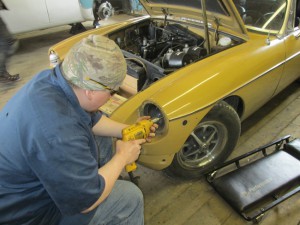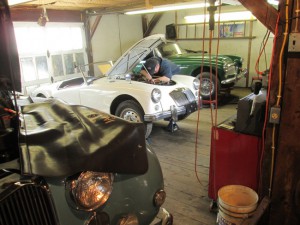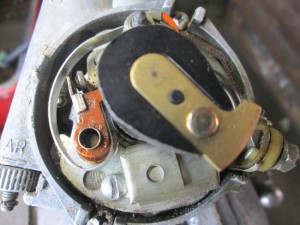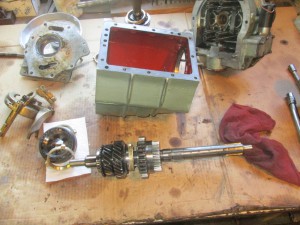Here’s an archival photograph from March of John getting an MGB ready for the paint shop.
There are two basic types of paint jobs, a respray, where you scuff the old paint and shoot it, and a refinish, where you take the car back to bare metal, repair any damage or imperfections and have at it with your primers, paints & clears.
It is always worth bearing in mind that you get what you pay for in this life, and a bare metal refinish up to the door jambs is gonna cost you two or three times as much as the Earl Schieb job, so if you’re sending the old jalopy to the French Cuff & Silk Cravat Auctions Llc. 1,000 car Spring Extravaganza, that’s the way to go. Goodness knows, we’ve spent enough time with those cars post-auction to know how that works.
After sort of a dry spell we’ve got some MGA work back in the shop again. In the photo at left John can be seen taking a close look at the carburetors on this car. It’s actually an MGA 1600 with MGA 1500 parking lights. There must be a story there somewhere, but we don’t know it.
The work sequence here is very routine: Get it running and assess the drivetrain, which appears to be O.K. and then strip out the complete brake & clutch hydraulics for overhaul. All of which is very straight forward.
We think we know the reason for the previously reported poor running condition: The left-hand contact on the point set is M.I.A. which is yet another good argument for a ‘set it and forget it’ electronic ignition. Points ignition seems to be both the bane and the salvation of our existence. Later Lucas distributors use a point gap of .014″-.016″, and when the gap drops below about .012″ performance starts to tail off quite dramatically. A number of years ago I talked a customer out of an engine overhaul he didn’t need just by re-gapping his points. We gap a new set of points at .017″ to allow for bedding-in.
A black MGA 1600 MKII is waiting in the wings for a transmission overhaul.
This is a center-shift gearbox out of an Austin Healey 3000 MkII. The overdrive unit is at the top right. The TX came out to staunch a rather large leak from the 50 year old front oil seal, but it crunched on the 3rd gear upshift, too.
This condition, which is often-times much more pronounced in 2nd, is caused by wear on the synchronizer bauking rings. They’re the brass-guys leaning up against the 3rd/4th synchronizer assembly and sitting on the mainshaft splines between 2nd gear and the 1st gear sliding hub assy.
Their job is quite simple: As the sliding outer hub pushes them over the next gear, the internal teeth grip the cone shaped surface on the gear to either speed it up or slow it down to match the speed of the gear you’re just leaving, and that results in a crunchless shift. You can help them out a lot if you at least double clutch your down shifts, although I’ll be the first to admit that if you’re out wheeling your Morgan or early E-type around, chances are you’re probably double clutching your upshifts, too.







